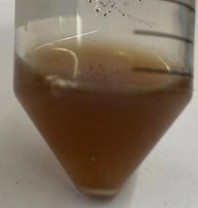Part:BBa_K3628011
HpaB SMS
Description
This part codes HpaB, which can convert tyrosine into levodopa by consuming FADH2. In the experiment, we applied this part with HpaC, and their assembly constructs T7 promoter-RBS-HpaB SMS-RBS-HpaC SMS, which codes HpaBC. HpaBC can therefore convert tyrosine into levodopa.
Usage and Biology
Experiments & Results
1、Test HpaBC yielding efficiency
To examine the efficiency of HpaBC-SMS, we transform pHpaBC-SMS into a DH10b strain which is integrated with T7RNAP constitutive expression unit,which confirm the practicability of our fermentation system.
Experimental setup
- we first prepare DH10b[1], a strain that is integrated with T7RNAP constitutive expression unit, as component cell.
- Then we transform HpaBC-WT and HpaBC-SMS to component cells, respectively.
- The monoclonals are later overnight cultivated, and is then inoculated into fresh LB medium with a proportion of 1:200.
- The samples are then cultivated for 48h, in 37℃, 220rpm. Samples are taken out, after the 48-hours-long cultivation, to measure for its L-dopa concentration.
- The detailed description of measurement is illustrated below
Results
We culture our strains overnight and find medium turning dark.
To explore the best substrate concentration for L-Dopa production, In this test, leveled concentrations of the substrate, tyrosine, (0mM, 0.03mM, 0.3mM, 1.5mM, 3mM, 4.5mM, 6mM, 9mM) are prepared. We then inoculate Bacteria in 7 mL LB medium and take for 500μL each time. They are taken at specific points: 30h, 39h, 42h, 50h. We use microplate reader to measure its absorbance under OD 400, and we determined the production of L-Dopa with standard curve of levodopa.
The results are listed below.
The following column is about levodopa concentration in 3mM samples cultured for 42h.
We can observe from the graph that, after codon optimization, HpaBC has presented higher biological activity. In the cultivation where the concentration of tyrosine is 3mM, after 42 hours of cultivation, the production of levodopa in HpaBC-WT is 0.88 mol/L; in the cultivation of HpaBC-SMS, the production is 1.12 mol/L. We thus chose HpaBC-SMS for the following experiments.
2、Yielding Levodopa under light regulation
We combine the light regulation system and HpaBC, to determine whether HpaBC yielding can be controlled under light regulation.
Experimental setup
- In this experiment, we transform pHpaBC-WT and plasmids which contain photoswitches simultaneously into DH5α. We culture the strain overnight to get bacteria culture.
- The monoclonals are later overnight cultivated, and is then inoculated into fresh LB medium with a proportion of 1:200.
- Samples are taken for 1mL each time at several points: 8h, 16h, 24h, 28h, 32h, 44h.
- We applied a levodopa measurement for each sample.
Results
[[Part:BBa_K3628024|J23106-RBS-T7 RNA polymerase N 1~564-Vvd-RBS-Vvd-T7 RNA polymerase C 565~883] and [[Part:BBa_K3628023|J23106-RBS-T7 RNA polymerase N 1~179-pMagFast2-RBS-nMagHigh1-T7 RNA polymerase C 180~883] are efficient and picked. In the following graph, we illustrate the yielding condition of the two photoswitches under different culture conditions.
In this graph, we can see our engineered E. coli produce levodopa at a relatively high rate in the Light group, but lower in the Dark group. <be>
NDNF_China 2021’s Characterisation
In summary: we have tested this genetic part in the Hidro system and we found that this genetic part could be well implemented as a part of the L-dopa metabolic pathway in the Hidro system for L-dopa expression induced by caffeine. Below is the detailed description.
In the project of NDNF_China 2021, we hope to help engineered strains work beyond the laboratory in a safe, stable and traceable way. So we present Hidro: a hydrogel system enclosing engineered bacterial strains. The outer layer of Hidro is a compact shell, offering both protection and containment, preventing the strains from escaping into the wild; the inner core of Hidro provides a supportive environment for them under harsh conditions, thus enabling their stable function; A genome-integrated Tracing and Control system offers tracking and specific killing of engineered strains in case of emergencies. We have experimentally demonstrated that Hidro can be implemented in diverse scenarios, such as heavy metal sensing, food-quality detection, drug secretion, etc. The Hidro system has the great potential to promote synthetic biology applications beyond the laboratory. The Hidro system has the potential for safe drug delivery in food and the human gut (See more information in NDNF Proposed Implementation). So we then designed a caffeine–controlled L-Dopa production system based on the switch designed here (Figure 1A).
Derived from the biosynthesis of L-tyrosine (Figure 1B), L-Dopa is a naturally occurring amino acid which acts as a precursor to a number of neurochemicals such as adrenaline and dopamine. L-Dopa is an amino acid which is made and used as part of normal biological functions in humans. We replace the output gene with L-Dopa metabolic pathway HpaB and HpaC, each with a specifically designed RBS (Figure 8A). After 24 hours of incubation in tube, we removed the Hidro beads, centrifuged the liquid and took out the supernatant for L-dopa concentration measurement. From the result shown in Figure 8C, we can see that Hidro group showed L-dopa production compared to those in group group. It means that Hidro can realize the Sensing and Reponding process. It further proves that Hidro has a great potential to be applied in Health.

Figure 1: (A) The schematic of caffeine–controlled genetic switch encapsulated in the Hidro system to produce L-dopa; (B) The metabolic pathway from L-tyrosine to L-Dopa. (C) L- Dopa concentration measurement in the caffeine–controlled L-Dopa production Hidro system.
Sequence and Features
- 10COMPATIBLE WITH RFC[10]
- 12COMPATIBLE WITH RFC[12]
- 21COMPATIBLE WITH RFC[21]
- 23COMPATIBLE WITH RFC[23]
- 25COMPATIBLE WITH RFC[25]
- 1000COMPATIBLE WITH RFC[1000]
| None |





